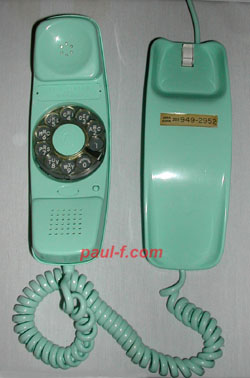WE Trimline Field Trial Sets
Trimlines were announced in April 1964 and shipped in 1965.
©2002-13 paulf. All rights reserved.
| (What's this copyright
notice?) |




12/63 Desk Telephone
"Floating" finger stop travels about 30 degrees.
Recall switch (not in center as in later models). Push once to toggle between "on hook" and "off hook". Always returned to "on hook" when handset is returned to base. Apparently not momentary contact ("flash") like later models.
Dial Light operates when "off hook". Requires a 2012A transformer.
Hardwired, 4-conductor handset cord.
The metal bottom plate also acted as a weight. The bottom housing is two plastic pieces, with the metal plate attached over the plastic on the bottom.
Available in black and all standard colors.
The dimensions are very close to the final production set. Slight differences include the shape of the plunger, the location of the recall button, the size of the access plate above the dial (changed from stating "Bell System made by Western Electric" to a number card), the use of 3 screws to hold the handset together versus two in the production set and the detailing in the angle of the transmitter and horizontal line between the transmitter and dial. The bottom housing was changed to a top housing only, using the metal bottom plate as the base to mount components. Lettering on the number plate was changed from an arc to straight line. Production sets used plug-ended cords.

The field trial box is a Princess
box, complete with oval cutout inside - but with field trial Trimline
set graphics. Note the oval below the dial and circle to its
right for the recall button.
Box marked: F55580 1/64


Available only in white (-58), wall mounted.
"Floating" finger stop travels about 30 degrees.
Recall switch (not in center as in later models). Push once to toggle between "on hook" and "off hook". Always returned to "on hook" when handset is returned to base. Apparently not momentary contact ("flash") like later models.
Dial Light operates when "off hook". Requires a 2012A transformer.
Hardwired, 4-conductor handset cord.
Can be wired for 4-party full selective or 8-party semiselective ringing.
- - - - - - - -
Please contact me if you have one
for sale
or photos of an actual phone to share.
- - - - - - - -
Information from:
BSP 502-150-900PT
Issue A, April 1964
Provided by the Pioneer Museum
Thanks to Steve Cichorsky
or photos of an actual phone to share.
- - - - - - - -
Information from:
BSP 502-150-900PT
Issue A, April 1964
Provided by the Pioneer Museum
Thanks to Steve Cichorsky


854A Network on Flex-strip provides 500-type set transmission characteristics.
F-56594 Telephone Base
"Dial-In-Handset" (NOT Trimline)
From the BSP:
"1.03 This handset is designed primarily for use in hospitals and other similar institutions. However it may be installed elsewhere
Note: Do not confuse this handset with TRIMLINE telephone sets."
Available only in white (-58), wall mounted.
"Floating" finger stop travels about 52 degrees. 10A dial.
Recall switch (in the center below the dial). Operates the K1 relay in the base, which opens tip and ring and the lamp circuit. Always returned to "on hook: when handset is returned to base. The switch is operated by a blue button.
Dial Light operates when "off hook". Requires a 2012A transformer.
F-56666 plug-ended retractile handset cord. 5 conductors with plug on handset end and spade-tips for base connections.
Can be wired for 4-party full selective or 8-party semiselective ringing.
A maximum of 35 handsets can be operated properly from one 18-volt AC 2.0 amp fuse or tap. Must be fused again in groups of five at 0.5 amp each.
This set is closer to the production sets than those above. It has the now familiar recall switch, handset contouring, number card holder on the handset, above the dial and plug-ended cords.
- - - - - - - -
Please contact me if you have one
for sale
or photos of an actual phone to share.
- - - - - - - -
Information from:
BSP 502-150-901PT
Issue B, January1967
Provided by the Pioneer Museum
Thanks to Steve Cichorsky
or photos of an actual phone to share.
- - - - - - - -
Information from:
BSP 502-150-901PT
Issue B, January1967
Provided by the Pioneer Museum
Thanks to Steve Cichorsky
